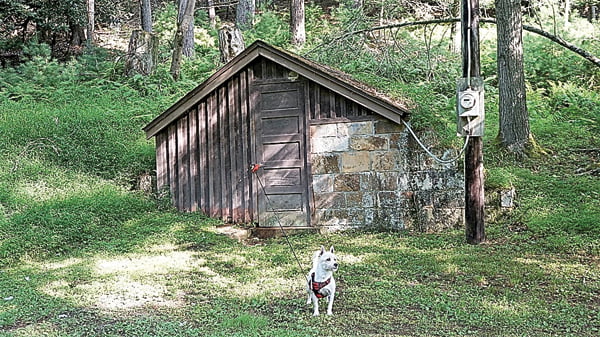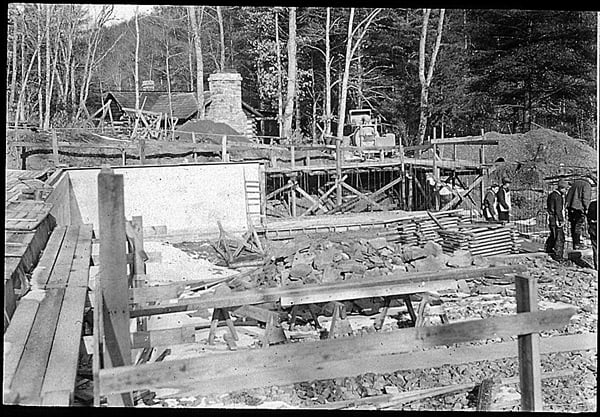
Ken Springer
Watoga Park Foundation
Watoga Swimming Pool ~ once deemed “way too cold” by the Polar Bear Club
Part One
Long before there was a swimming pool at Watoga State Park there were game rearing pens in that very location. Napoleon (Nap) Holbrook, West Virginia’s first gamekeeper, lived in present-day Cabin 20 and tended to his deer and turkeys there for a few years in the 1930s. Sometime around 1936, he took up housekeeping and game-rearing in the Workman Cabin with his young wife and baby. The removal of the game pens cleared the stage for construction of a swimming pool and parking lot.
If you have been to the swimming pool at Watoga, try to visualize the parking lot. Now imagine the entire parking lot as a field and that is how it looked when Nap lived there tending to his game. When Nap was in the later years of his life he related a story to former Park Superintendent Mark Wylie about the burial of a mule in that field – that didn’t quite turn out the way he had intended.
One afternoon, Nap’s old mule just fell over dead in that field. And since Nap did not have a truck or a tractor, he was left with the considerable problem of burying the mule. To Nap, it seemed the most logical thing to do was to bury that mule right where he fell.
So he set about digging a deep trench right alongside the long spine of the mule figuring that he could use a spud bar to pry the body of the animal right into the grave. By all accounts, Nap was a resourceful and intelligent man, but on that day he was a wee bit off on his judgment regarding the required depth of the excavation.
As hoped, the faithful old mule slid easily into the opening. A considerable amount of rigor mortis had set in during the hours of labor it took Nap to complete the job, so the carcass of the mule was as rigid as Nap’s spud bar; the beast’s four legs were sticking straight up out of its grave.

This, in itself, would not have been a big problem except for the fact that the creature’s legs were sticking up a good foot or so above ground level. Well, Nap returned to his cabin to retrieve the one tool that could solve this unfortunate predicament, a hand saw, or should I say, leg-saw. So the next time you visit the swimming pool just think about that poor old mule that may be buried right under your pickup truck.
By the time Watoga State Park officially opened on July 1, 1937, there were 14 miles of road within the park, several miles of trail and 18 cabins, and Watoga Lake was completed and available for swimming and boating. But even as more land was being appropriated during the early years of the 1930s, plans were already afoot to have facilities in the park that were commensurate with its size, that of being the largest state park in the system.
In today’s political lexicon the term “in their infinite wisdom” bears a pejorative, even sarcastic, connotation and sometimes for good reason, particularly when associated with certain government initiatives. But back in the 1930s, the term rang true; the years ahead would demonstrate that these park projects were indeed wise, and ultimately met with overwhelming public approval – think of our National Parks.
It was no surprise when construction started on the swimming pool in 1939, and when completed in 1940 it represented the last major project of the Civilian Conservation Corps in Watoga State Park.
Following the pool’s completion, the bathhouse that you currently know and appreciate did not exist; that would have to wait until the conclusion of World War II. Simple changing booths were built to afford privacy until the current bathhouse was built.
During the war many public projects either slowed down or came to a halt. Continued development of Watoga State Park resumed after the war when the bathhouse was built. Much of the rock for the stonework was quarried at the Scott farm on Droop Mountain. On your next visit take note of the beautiful keystone arch at the entrance to the bathhouse – it is the work of an artisan.
At some point in this Watoga Trail Report, I knew that I would have to address the legendary low temperature of the water in the swimming pool. To do this required taking an in-depth look at the park’s water systems, built in 1940. And that required talking with present and former employees of Watoga State Park.
The water system that feeds the pool as well as the bathhouse, picnic shelter, cabins, restrooms and other facilities in the vicinity started with drilling a deep well. Over the well, a pump house was built. The water is brought up from deep and cold aquifers where it is screened to remove sediment and then chlorinated to kill bacteria.
Then the clean, but still cold, water is pumped up to an underground reservoir, some 300 feet of elevation above the pump house. From this reservoir water is then supplied by gravity to the swimming pool, as well as other facilities. Worth mentioning here is that the water is stored in an underground tank, so at no point in this system does the water get an opportunity to warm up very much.
Where the water does not come from – as many people think when they first stick their toes into the pool – is from a frigid trout stream full of Arctic char. But that is now in the past.
So for you old-time visitors to Watoga’s swimming pool, you will be happy to learn that the Watoga State Park Foundation raised money to install an array of solar panels to heat the water. This has resulted in an average increase in water temperature of 12 degrees F, or from a previous temperature of 63 degrees to a present 75 degrees F.
This is, of course, an average temperature increase, and daily temperatures will fluctuate according to the outside ambient temperature, sunlight, wind and cloud cover.
Now that you know more than you really ever wanted to know about Watoga’s swimming pool, it is time to hear your stories about the old pool. In the next Watoga Trail Report we will hear these stories in your own words.
If you have a story about the swimming pool, please let me know.
Happy Hiking and be sure to take water with you.
Ken Springer
Ken49bon@gmail.com


